Abstract
A laboratory investigation was conducted on cultures collected from travelers before, during, and after a trip to Mexico to characterize the etiology of traveler's diarrhea. Four laboratory methods for detecting enterotoxigenicity of Escherichia coli were evaluated: the infant mouse assay, the Chinese hamster ovary (CHO) cell assay, the Y1 adrenal cell assay, and the rabbit ileal loop. Although a number of common enteric pathogens were identified as a cause of traveler's diarrhea, including six serotypes of Salmonella, two serotypes of Shigella, Vibrio parahaemolyticus, Giardia lamblia, and Entamoeba histolytica, enterotoxigenic Escherichia coli was most commonly isolated. Strains were identified that produced only heat-labile enterotoxin (LT), only heat-stable enterotoxin (ST), or both LT and ST. The infant mouse assay yielded results falling into two distinct groups, providing a clear separation of positive and negative cultures. The CHO assay also formed two groups, with positive cultures producing 11% or more of the elongated cells. There was good agreement between the CHO and the Y1 adrenal cell assays for detection of LT. The adrenal cell system for detection of LT was more suitable than the CHO assay for processing large numbers of specimens because of the miniculture modification of this method utilized in this study. The infant mouse method was a simple and reliable method for detecting ST.
Full text
PDF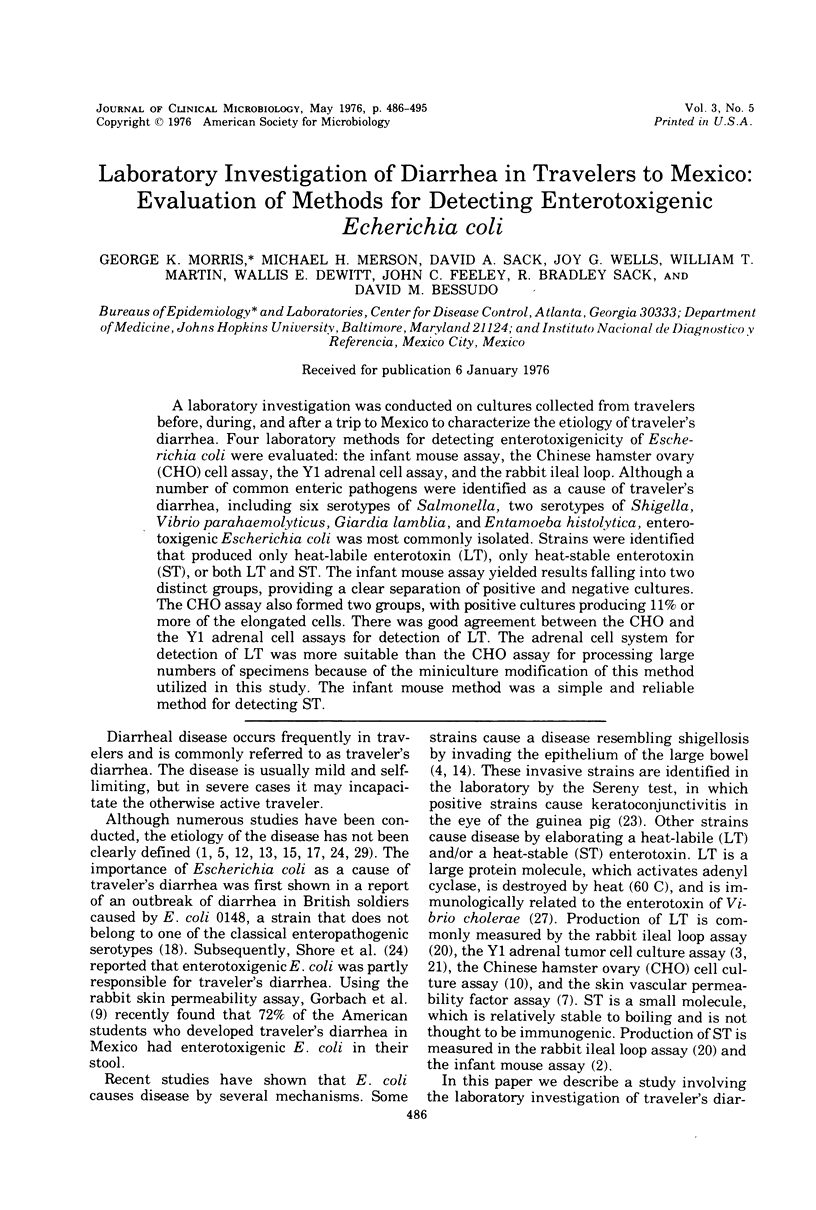
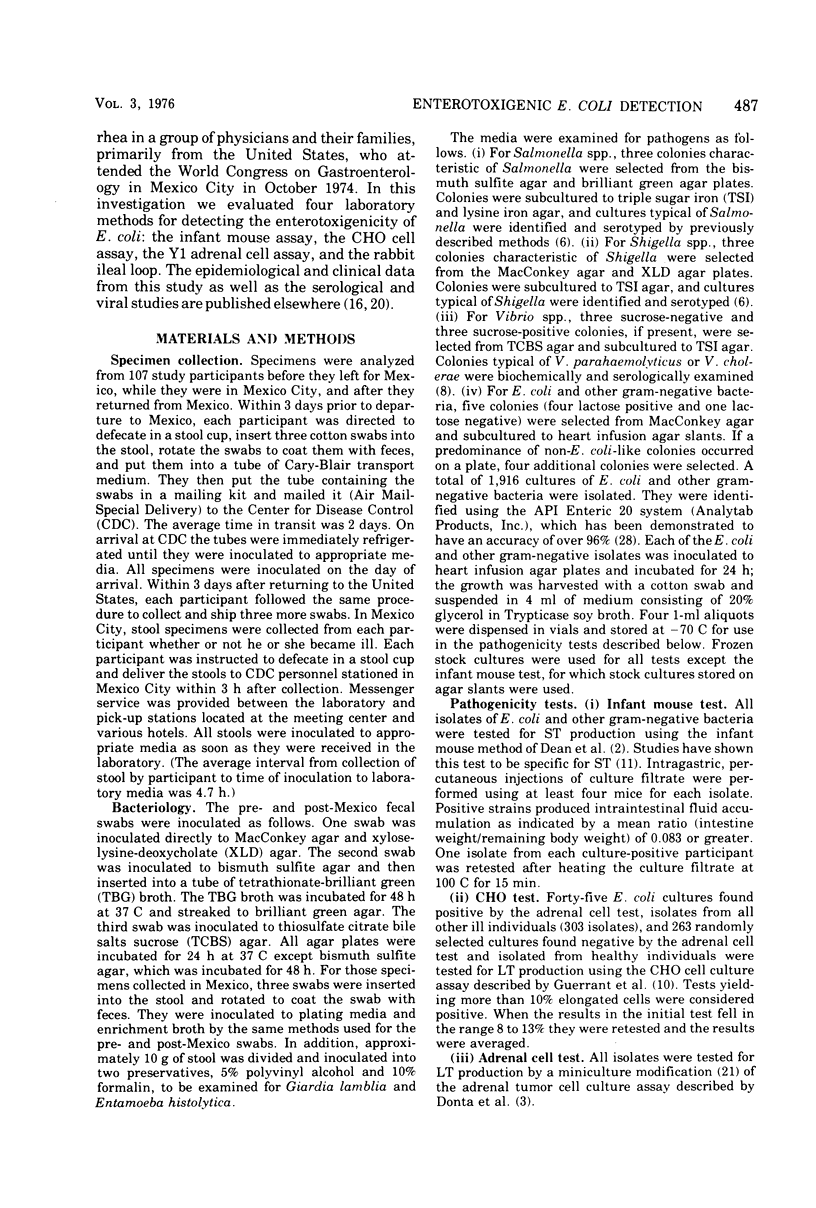
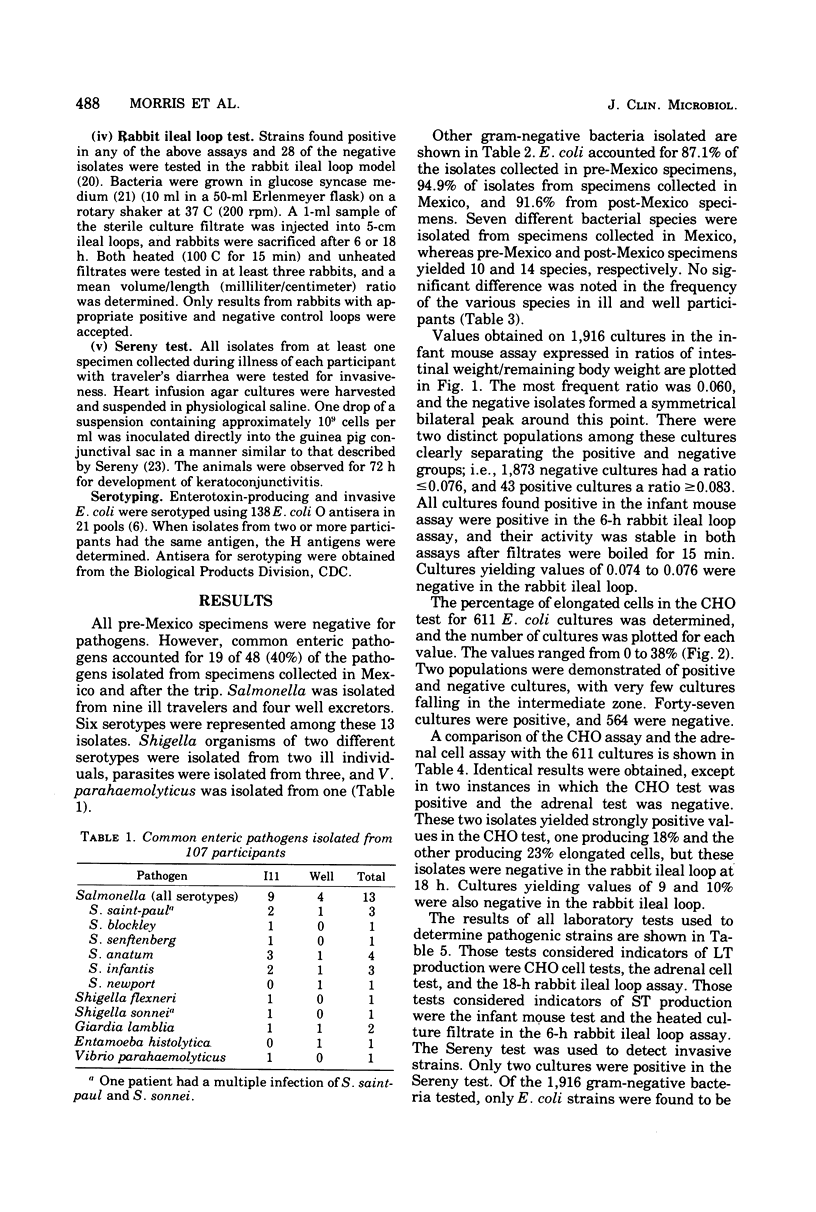
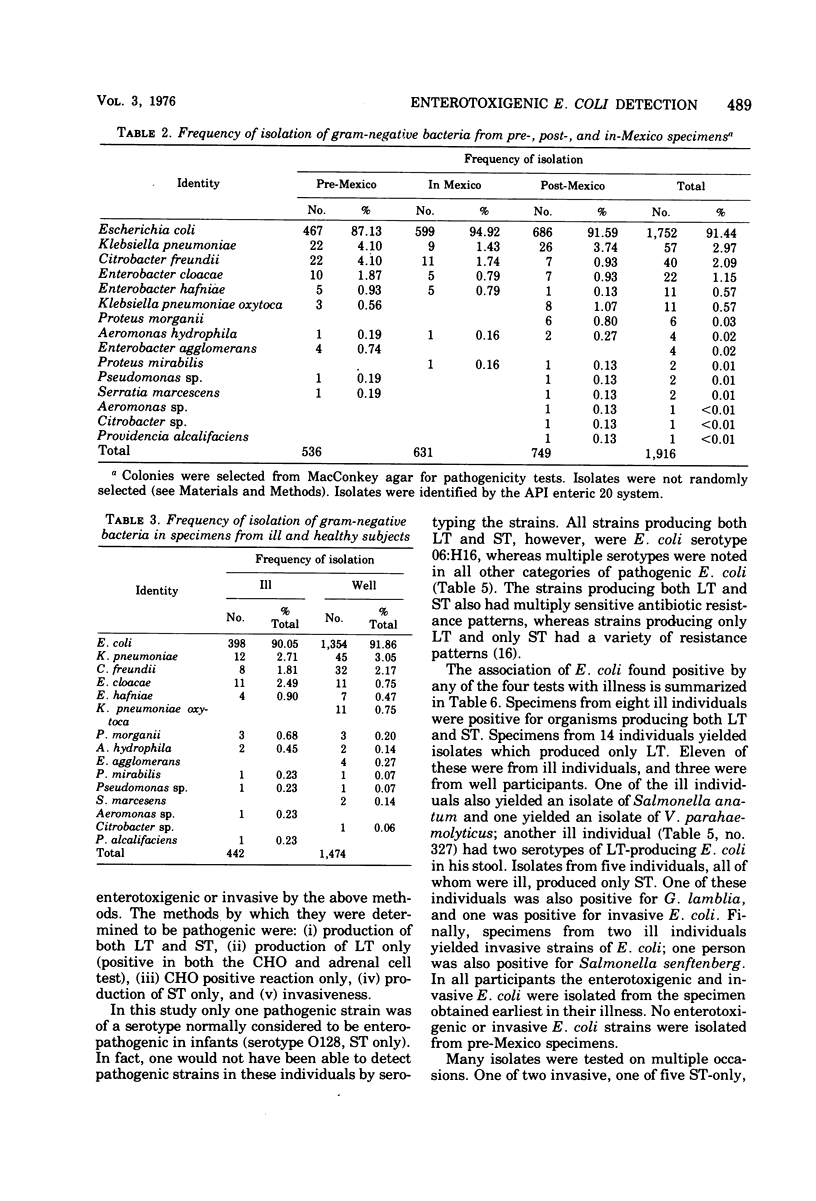
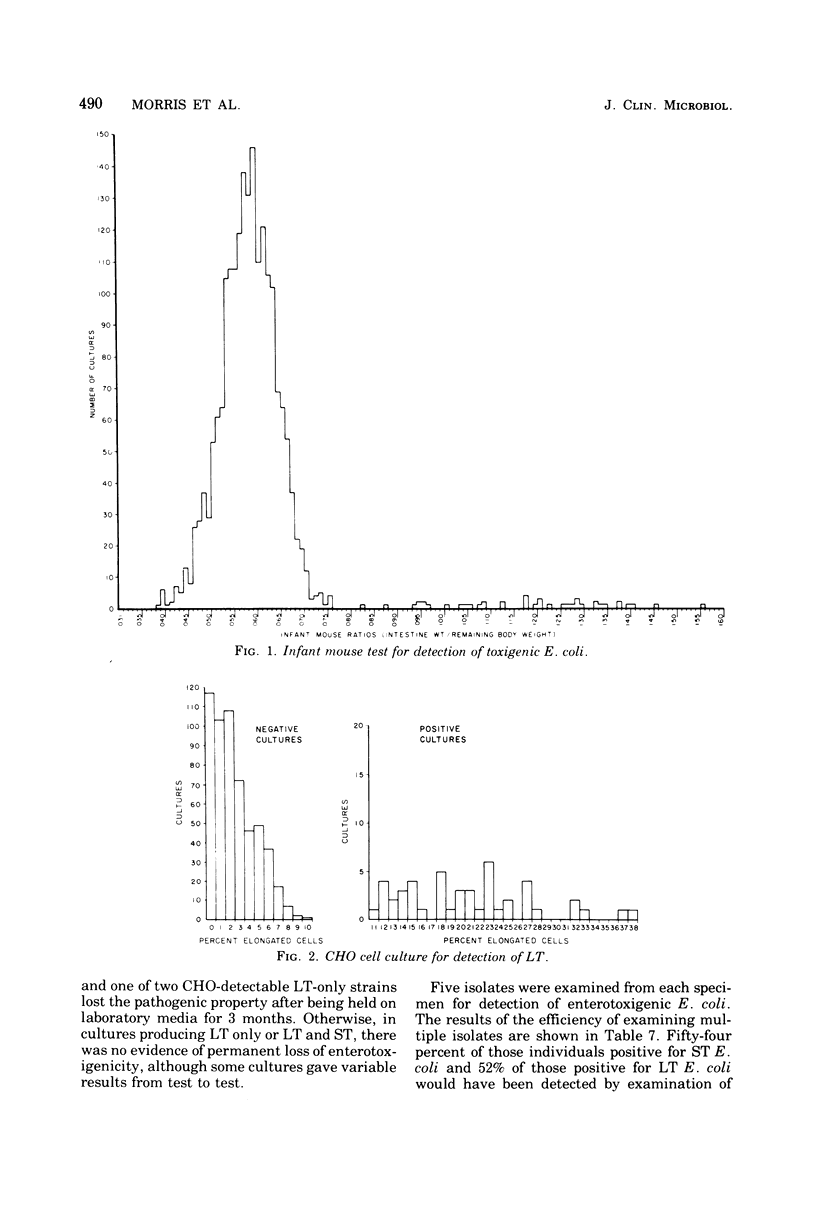
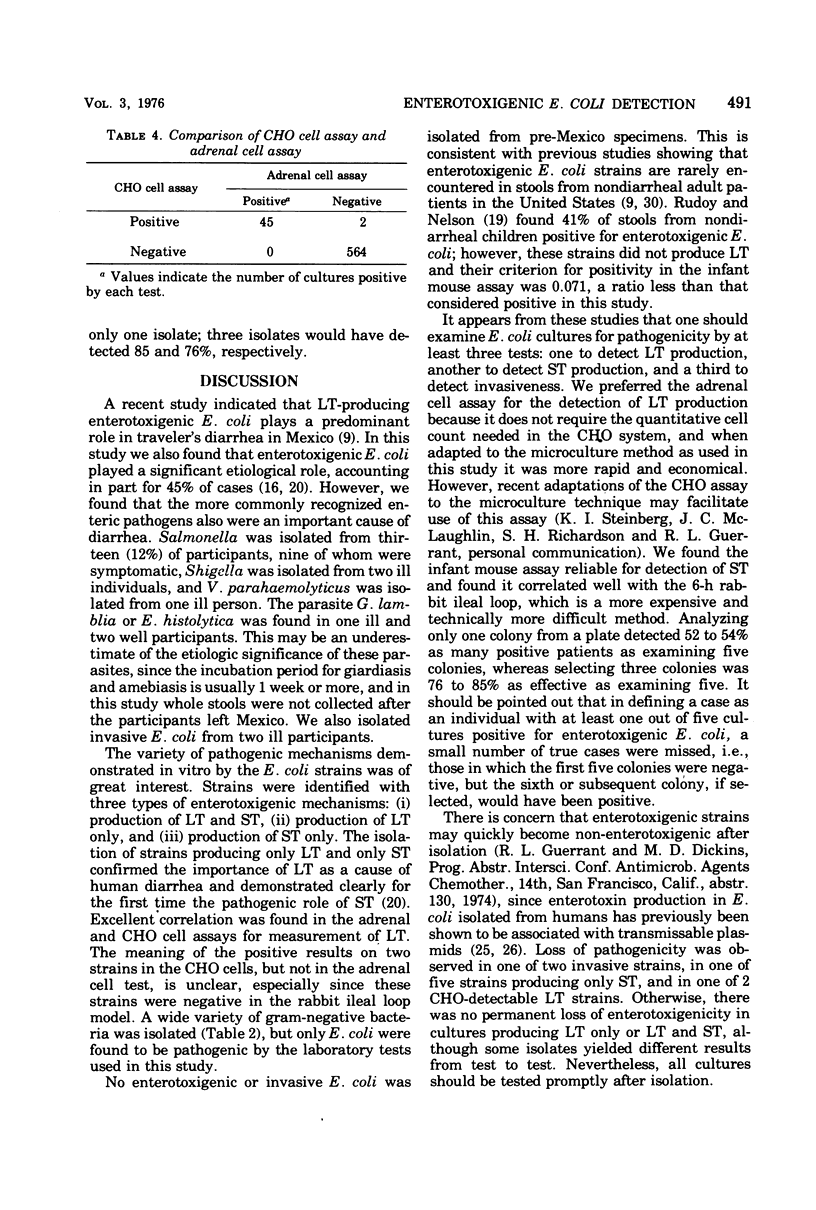
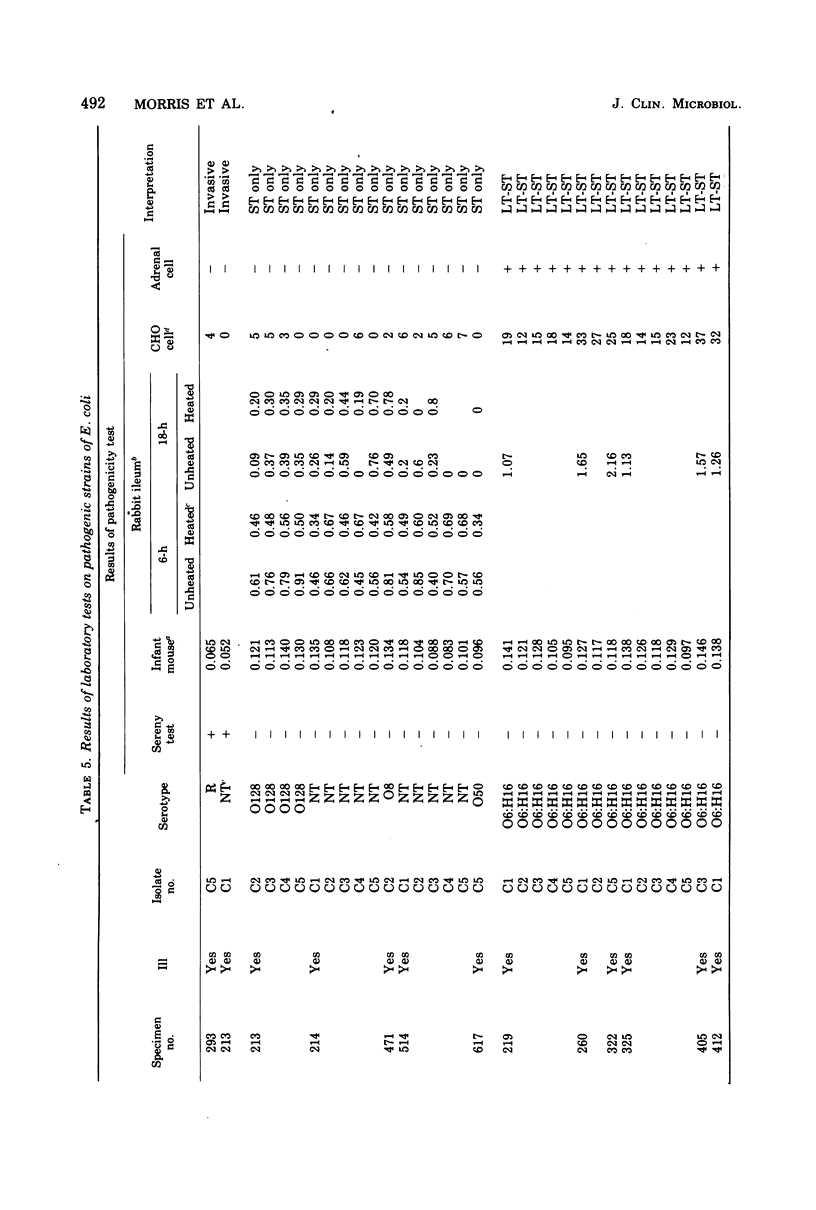
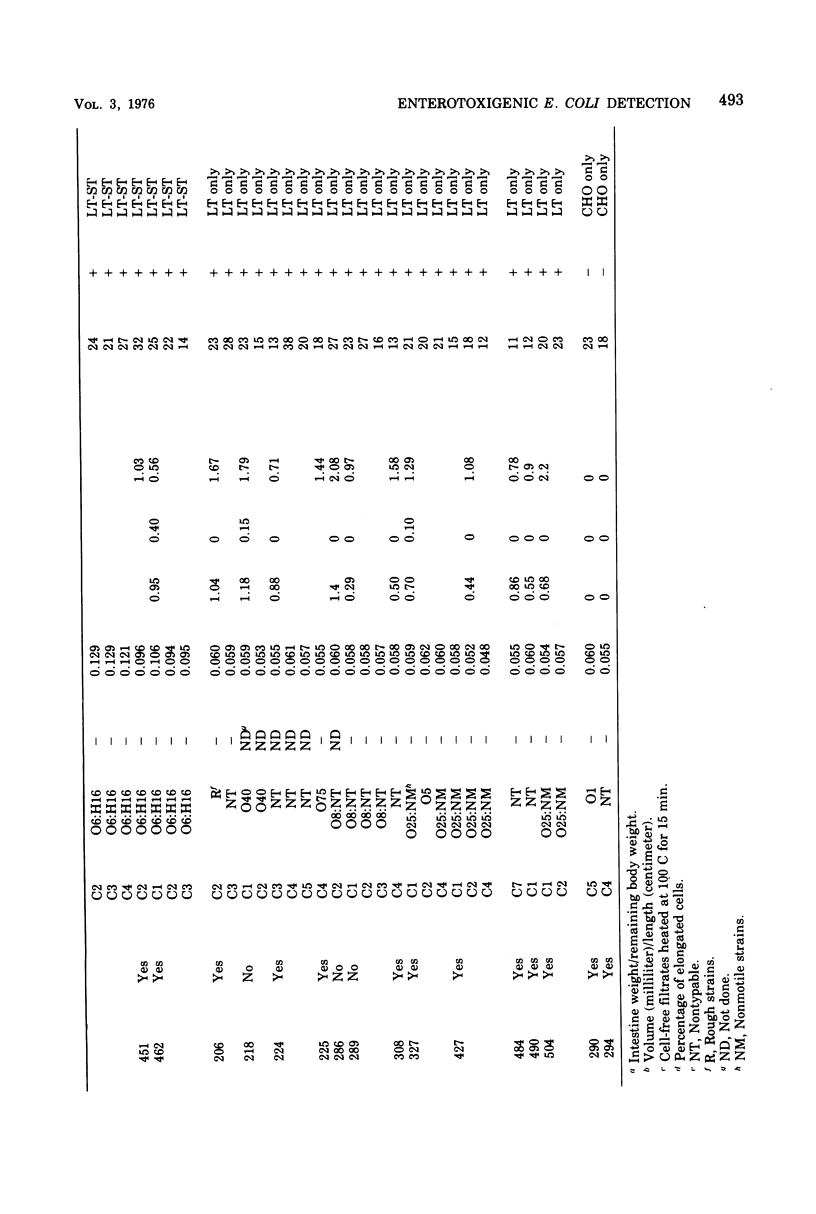
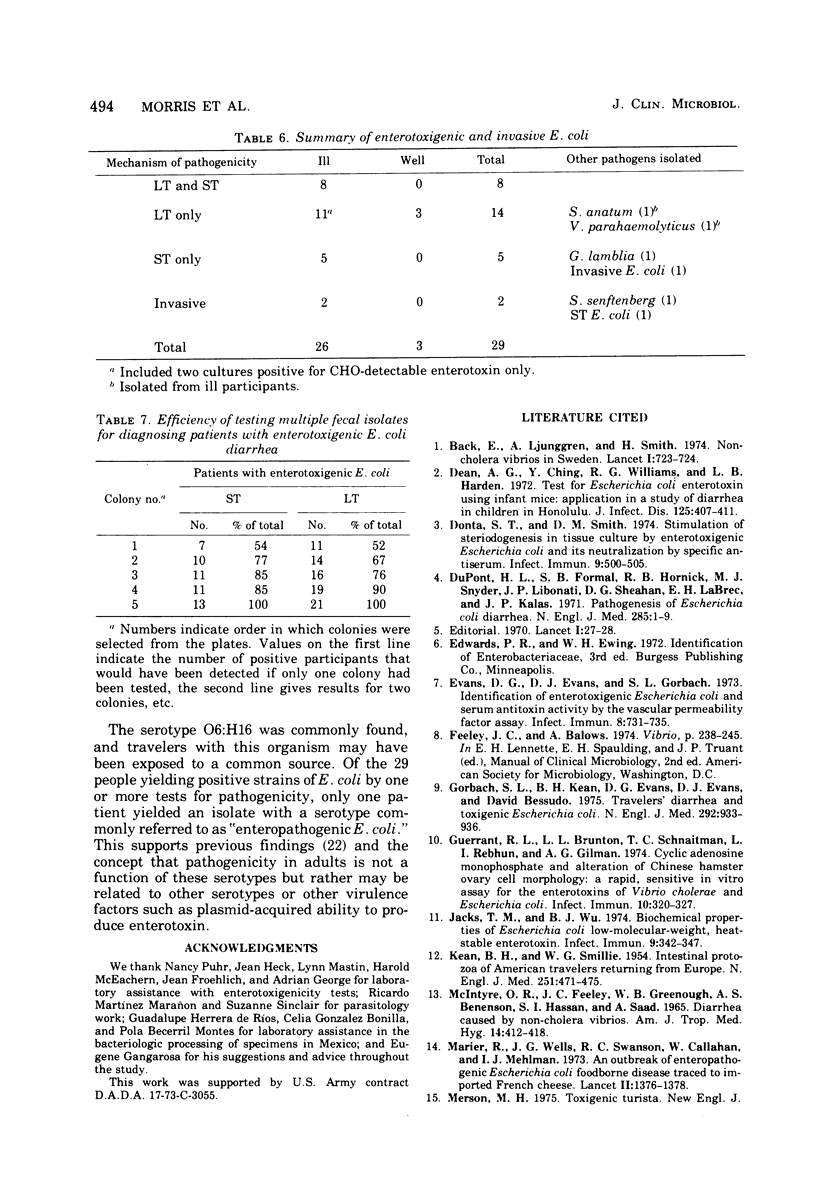
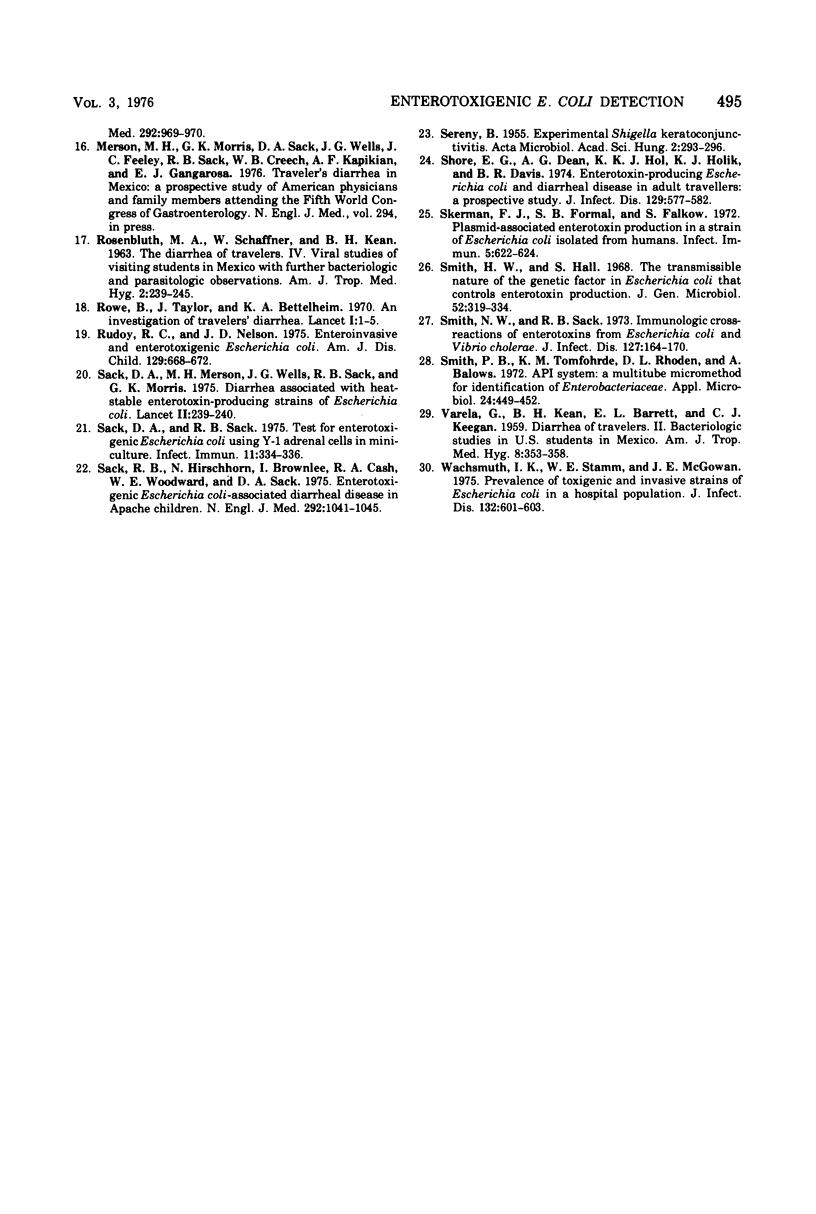
Selected References
These references are in PubMed. This may not be the complete list of references from this article.
- Bäck E., Ljunggren A., Smith H., Jr Non-cholera Vibrios in Sweden. Lancet. 1974 Apr 20;1(7860):723–724. doi: 10.1016/s0140-6736(74)92921-3. [DOI] [PubMed] [Google Scholar]
- Dean A. G., Ching Y. C., Williams R. G., Harden L. B. Test for Escherichia coli enterotoxin using infant mice: application in a study of diarrhea in children in Honolulu. J Infect Dis. 1972 Apr;125(4):407–411. doi: 10.1093/infdis/125.4.407. [DOI] [PubMed] [Google Scholar]
- DuPont H. L., Formal S. B., Hornick R. B., Snyder M. J., Libonati J. P., Sheahan D. G., LaBrec E. H., Kalas J. P. Pathogenesis of Escherichia coli diarrhea. N Engl J Med. 1971 Jul 1;285(1):1–9. doi: 10.1056/NEJM197107012850101. [DOI] [PubMed] [Google Scholar]
- Evans D. G., Evans D. J., Jr, Gorbach S. L. Identification of enterotoxigenic Escherichia coli and serum antitoxin activity by the vascular permeability factor assay. Infect Immun. 1973 Nov;8(5):731–735. doi: 10.1128/iai.8.5.731-735.1973. [DOI] [PMC free article] [PubMed] [Google Scholar]
- Gorbach S. L., Kean B. H., Evans D. G., Evans D. J., Jr, Bessudo D. Travelers' diarrhea and toxigenic Escherichia coli. N Engl J Med. 1975 May 1;292(18):933–936. doi: 10.1056/NEJM197505012921801. [DOI] [PubMed] [Google Scholar]
- Guerrant R. L., Brunton L. L., Schnaitman T. C., Rebhun L. I., Gilman A. G. Cyclic adenosine monophosphate and alteration of Chinese hamster ovary cell morphology: a rapid, sensitive in vitro assay for the enterotoxins of Vibrio cholerae and Escherichia coli. Infect Immun. 1974 Aug;10(2):320–327. doi: 10.1128/iai.10.2.320-327.1974. [DOI] [PMC free article] [PubMed] [Google Scholar]
- Jacks T. M., Wu B. J. Biochemical properties of Escherichia coli low-molecular-weight, heat-stable enterotoxin. Infect Immun. 1974 Feb;9(2):342–347. doi: 10.1128/iai.9.2.342-347.1974. [DOI] [PMC free article] [PubMed] [Google Scholar]
- KEAN B. H., SMILLIE W. G. Intestinal protozoa of American travelers returning from Europe. N Engl J Med. 1954 Sep 16;251(12):471–475. doi: 10.1056/NEJM195409162511204. [DOI] [PubMed] [Google Scholar]
- MCINTYRE O. R., FEELEY J. C., GREENOUGH W. B., 3rd, BENENSON A. S., HASSAN S. I., SAAD A. DIARRHEA CAUSED BY NON-CHOLERA VIBRIOS. Am J Trop Med Hyg. 1965 May;14:412–418. doi: 10.4269/ajtmh.1965.14.412. [DOI] [PubMed] [Google Scholar]
- Merson M. H. Editorial: Toxigenic turista. N Engl J Med. 1975 May 1;292(18):969–970. doi: 10.1056/NEJM197505012921809. [DOI] [PubMed] [Google Scholar]
- ROSENBLUTH M. A., SCHAFFNER W., KEAN B. H. The diarrhea of travelers. IV. Viral studies of visiting students in Mexico with further bacteriologic and parasitologic observations. Am J Trop Med Hyg. 1963 Mar;12:239–245. [PubMed] [Google Scholar]
- Rowe B., Taylor J., Bettelheim K. A. An investigation of traveller's diarrhoea. Lancet. 1970 Jan 3;1(7636):1–5. doi: 10.1016/s0140-6736(70)90520-9. [DOI] [PubMed] [Google Scholar]
- Rudoy R. C. Enteroinvasive and enterotoxigenic Escherichia coli. Occurrence in acute diarrhea of infants and children. Am J Dis Child. 1975 Jun;129(6):668–672. doi: 10.1001/archpedi.1975.02120430008004. [DOI] [PubMed] [Google Scholar]
- SERENY B. Experimental shigella keratoconjunctivitis; a preliminary report. Acta Microbiol Acad Sci Hung. 1955;2(3):293–296. [PubMed] [Google Scholar]
- Sack D. A., Merson M. H., Wells J. G., Sack R. B., Morris G. K. Diarrhoea associated with heat-stable enterotoxin-producing strains of Escherichia coli. Lancet. 1975 Aug 9;2(7928):239–241. doi: 10.1016/s0140-6736(75)90958-7. [DOI] [PubMed] [Google Scholar]
- Sack D. A., Sack R. B. Test for enterotoxigenic Escherichia coli using Y-1 adrenal cells in miniculture. Infect Immun. 1975 Feb;11(2):334–336. doi: 10.1128/iai.11.2.334-336.1975. [DOI] [PMC free article] [PubMed] [Google Scholar]
- Sack R. B., Hirschhorn N., Brownlee I., Cash R. A., Woodward W. E., Sack D. A. Enterotoxigenic Escherichia-coli-associated diarrheal disease in Apache children. N Engl J Med. 1975 May 15;292(20):1041–1045. doi: 10.1056/NEJM197505152922001. [DOI] [PubMed] [Google Scholar]
- Shore E. G., Dean A. G., Holik K. J., Davis B. R. Enterotoxin-producing Escherichia coli and diarrheal disease in adult travelers: a prospective study. J Infect Dis. 1974 May;129(5):577–582. doi: 10.1093/infdis/129.5.577. [DOI] [PubMed] [Google Scholar]
- Skerman F. J., Formal S. B., Falkow S. Plasmid-associated enterotoxin production in a strain of Escherichia coli isolated from humans. Infect Immun. 1972 Apr;5(4):622–624. doi: 10.1128/iai.5.4.622-624.1972. [DOI] [PMC free article] [PubMed] [Google Scholar]
- Smith N. W., Sack R. B. Immunologic cross-reactions of enterotoxins from Escherichia coli and Vibrio cholerae. J Infect Dis. 1973 Feb;127(2):164–170. doi: 10.1093/infdis/127.2.164. [DOI] [PubMed] [Google Scholar]
- Smith P. B., Tomfohrde K. M., Rhoden D. L., Balows A. API system: a multitube micromethod for identification of Enterobacteriaceae. Appl Microbiol. 1972 Sep;24(3):449–452. doi: 10.1128/am.24.3.449-452.1972. [DOI] [PMC free article] [PubMed] [Google Scholar]
- VARELA G., KEAN B. H., BARRETT E. L., KEEGAN C. J. The diarrhea of travelers. II. Bacteriologic studies of U. S. students in Mexico. Am J Trop Med Hyg. 1959 May;8(3):353–357. doi: 10.4269/ajtmh.1959.8.353. [DOI] [PubMed] [Google Scholar]
- Wachsmuth I. K., Stamm W. E., McGowan J. E., Jr Prevalence of toxigenic and invasive strains of Escherichia coli in a hospital population. J Infect Dis. 1975 Nov;132(5):601–603. doi: 10.1093/infdis/132.5.601. [DOI] [PubMed] [Google Scholar]


